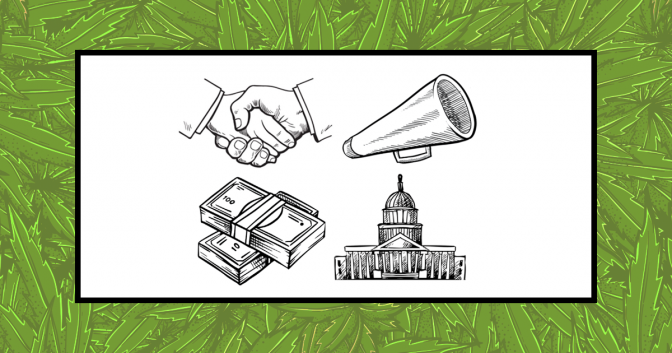Freedom Leaf’s Guide to Cannabis Activism

Legalizing marijuana is a lot of work. Here are four steps you can take to achieve your goals.
In my dozen years of marijuana-activist journalism, one of the questions I’ve heard most often is “When do you think they’re going to legalize marijuana in my state?” I always respond, “That’s the wrong question. When are you going to legalize marijuana in your state?”
If you’re waiting for them to legalize marijuana, you might be in for a long wait. The way marijuana-law reform happens is when ordinary people like you stand up, band together and organize for change.
Activism is more than just logging on to Facebook and sharing information about cannabis and marijuana-law reform with your friends. Activism means you must act.
There are four elements involved in making social change: activists, supporters, voters and laws. If legalization is your road trip’s destination, then your city or state is the car, activists are the engine, supporters are the fuel, voters are the countryside, and lawmakers and initiatives are the roads.
 Step 1: The Importance of Meetings
Step 1: The Importance of Meetings
Like an eight-cylinder engine is more powerful than a four-cylinder, your reform engine is more powerful with more activists. To build that group, you need to hold public meetings.
Don’t be worried if you have nothing to deliver at your first meeting. Use it to network with other like-minded people and ask what reforms they’d like to work on. Reach out to national organizations like NORML, SSDP, ASA, Women Grow, and LEAP to ask if they have anyone who could speak at your meeting. Look for a sympathetic city council member or state legislator who’d appear for a Q&A session.
From these public meetings, you’ll build a cadre of dedicated people who are ready to help you take your public activism to the next level.
TIP: You can usually get a room for little to no cost at the local library or community college. Bars and clubs are another option.
 Step 2: Rallies, Protests, Marches and Festivals
Step 2: Rallies, Protests, Marches and Festivals
The fuel for your activism push is acquired through public events. Rallies are generally when people gather in one place to support something. Protests are fixed gatherings to oppose something. Marches are moving examples of either. Festivals are day-long rallies that usually incorporate entertainment and vending.
You can generally gather on public property, such as in parks, without a permit so long as you aren’t erecting stages with loudspeakers. For a larger gathering with such infrastructure, you’ll likely
need to work with city officials to secure a permit. For marching, usually you can traverse the sidewalks without permits, but once you take to the streets, permits are required.
Make sure to have a lawyer. City officials and law enforcement may try to derail your events because they don’t like the content of your speech, but they’ll often back down once the magic “lawyer” word is uttered—and if they don’t, your lawyer can fight them in the courts. It’s also good to have a lawyer present to tell participants how to assert their rights if police start making possession or public-smoking arrests.
Have good signs and be media-savvy. Make your most sympathetic patient or conventional soccer mom or clean-cut student available to reporters. Explain not only why your proposed reform is important to you, but why it’s vitally necessary for everyone else, too.
TIP: When being interviewed, deliver a provocative statistic or powerful anecdote in just six to ten seconds.
 Step 3: Conferences, Fundraising, Polling and Media
Step 3: Conferences, Fundraising, Polling and Media
Your activist engine could have a full tank of support, but if you don’t know which roads lead to your destination, you’re just wasting gas. Focusing your organization on defining its goals can be facilitated through a reform conference, where activists from areas of the state that vary in support for reform gather to learn from each other and from national experts brought in to tell about successes elsewhere. “University and college campuses are good locations for conferences, especially if there’s a student group willing to sponsor them,” says Dan Viets, executive director of Missouri NORML. “Usually, these venues are free to recognized student organizations. Progressive churches, like Unitarian Universalists, are also good options.”
Generate money through selling organizational merchandise, collecting membership dues and accepting donations, but your biggest fundraising will happen at festivals and conferences. At first, you may struggle just to break even on these events, but if they’re successful (and lead to media exposure and legislative progress) you can begin to attract bigger investments in your activism.
“The majority of our festival funding comes from vendor fees and board-member personal contributions,” advises Serra Frank, who runs the Boise Hempfest. “Most of the funding comes in just weeks before the festival, so remaining patient and focused on the end goal is definitely a big part of fundraising.”
Once funds have been sufficiently raised, start polling. This is where the politics can be difficult. Your supporters may want to go further than possible. They may want legalization, when only decriminalization is attainable. They may want a medical-marijuana law, when only CBD oil has the votes needed to pass. They may withhold support and funding for lesser goals, or they may split from your group to follow their goals.
Polling is the GPS for your reform road trip. Serious supporters will respond to polling, and you can position your group as the sensible activists willing to accept reality and make reasonable compromises. Sometimes the group that splits away from you provides a counter-example that makes you look more professional.
Most local polling on marijuana issues isn’t done as a separate poll, but rather as a question or two included in more general surveys already being conducted by local news stations, colleges and universities, and private pollsters.
When you have the results of your poll, you’ll need to hold a press conference. While your public events have helped build legitimacy to your supporters, becoming a recognized group in the local media is what builds legitimacy with the public, especially the undecided voters you need to win elections and the legislators you need to help pass laws.
“Release a report with new data, announce a surprising endorsement, or reveal a petition with an impressive number of signatures,” offers Tom Angell, cannabis reporter for MassRoots. “Don’t just stand up there and deliver talking points that everyone has heard before. That’s not news.”
TIP: Your group can usually pay to get your question inserted into their poll.
 Step 4: Initiatives, Lobbying and Legislation
Step 4: Initiatives, Lobbying and Legislation
Now that you’ve gotten your polling and built your support, it’s time to start changing the laws. But where you live can make a big difference in how you do that.
Statewide ballot initiatives are how the first eight states to legalize marijuana—from Alaska to Maine—did it. That power, however, is limited to just 24 states, mostly in the West. The remaining states rely solely on legislators to make laws. Initiatives can reach further, since they depend on the votes of the public, which supports marijuana-law reform more strongly than elected officials do.
But too often in the initiative states, activists want to go for statewide adult-use legalization as a first reform. In the eight states that have legalized that, it took many smaller steps to get to there. They all went through local reforms, decriminalization, medical marijuana and failed legalization attempts before succeeding at statewide legalization.
Some states allow their cities and counties great latitude in regulating themselves. It’s called “home rule,” and it means activists can circulate petitions to change local ordinances. If you have this power, consider passing a reform in your municipality before jumping up to the statewide level. (For example, San Francisco voters endorsed legalizing medical marijuana in 1991, five years before the statewide law was enacted.) With local successes behind you, you’ll have more standing to build support and funding for your statewide push.
If you’re in a state without initiative power, then it’s up to the legislature. That’s where activist lobby days—when you gather your activists on one particular day to visit your representatives in person at the state capitol—come into play.
“It’s always good to wear a pin or some item of clothing that identifies your group members visually, so that, when they’re seen in the halls of the capitol, people automatically know why you’re there,” Viets advises. It’s also best to “dress for success” when visiting elected officials in statehouses or city halls.
While the idea of meeting elected officials can be intimidating, remember that these are your public servants and their job is to listen to you. “The name of the game is networking, making relationships and starting conversations,”says Sharon Ravert, Executive Director of Peachtree NORML in Georgia.
Sometimes lobby days will include an opportunity to present testimony in a hearing. Public comments are welcomed, but you usually must register before the hearing begins. Bring photocopies of your written testimony and any exhibits, enough for each member of the committee and their staff. Those materials can go into lengthy detail, but you may only have two or three minutes for your spoken testimony, so stick to the basics.
Lobby days are best organized around a bill or amendment that will be voted on by your representatives. Some states allow citizens to submit bills directly to the legislature, but usually the process begins with cultivating a relationship with a supportive lawmaker who will introduce the bill on behalf of your group.
“Showing up with pitchforks and flames is not an effective strategy to convincing legislators to support your bill,” explains Sam Chapman, an SSDP alumnus who now heads New Economy Consulting in Oregon. “If a legislator likes the bill and generally believes that it has a chance at passing, it will become a bill and will be assigned to a committee that focuses on the subject at hand.”
TIP: You don’t need to reinvent the wheel to take your reform road trip. Learn from the activists who have done it all and seen it all before. Most of them are very excited to pass their knowledge on to the next wave of reformers.
If you enjoyed this Freedom Leaf article, subscribe to the magazine today!

